To override CSS styles effectively, ensure your selector has equal or higher specificity than the original rule; 2. Place your custom stylesheet after external stylesheets to leverage cascade order; 3. Use !important sparingly, only when specificity cannot be matched or for debugging; 4. Increase specificity by combining selectors like .navbar .btn or using IDs cautiously; 5. Utilize :where() for low-specificity defaults and :is() for grouping with higher specificity; 6. Avoid inline styles due to maintenance issues and poor separation of concerns; 7. Use CSS custom properties (variables) for scalable and maintainable overrides, especially in themed designs; always prioritize proper specificity and load order to make targeted, safe changes without disrupting existing styles.

Overriding CSS styles is a common task when you're working with existing stylesheets—whether it's a framework like Bootstrap, a third-party library, or legacy code. Here’s how to do it effectively and safely.

1. Understand Specificity
CSS applies rules based on specificity. If two rules target the same element, the one with higher specificity wins.
Specificity hierarchy (from lowest to highest):

-
Type selectors (e.g.,
p,div) → 0,0,1 -
Class selectors, attribute selectors, pseudo-classes (e.g.,
.my-class,[type="text"],:hover) → 0,1,0 -
ID selectors (e.g.,
#my-id) → 1,0,0 -
Inline styles (e.g.,
style="...") → 1,0,0,1 -
!important→ overrides everything (but use sparingly)
? To override a style, your selector must have equal or higher specificity.
Example:

/* Original rule */
.button {
color: blue;
}
/* Override: same specificity, but must come after */
.button {
color: red;
}But if the original was:
#header .button {
color: blue;
}Then .button { color: red; } won’t override it unless you match or exceed that specificity:
#header .button {
color: red;
}2. Load Order Matters
When specificity is equal, the last rule defined wins.
? Correct:
<link rel="stylesheet" href="bootstrap.css"> <link rel="stylesheet" href="custom.css"> <!-- Your overrides go here -->
? Wrong:
<link rel="stylesheet" href="custom.css"> <link rel="stylesheet" href="bootstrap.css"> <!-- Bootstrap overrides your styles -->
So always place your custom CSS after external stylesheets.
3. Use !important (Only When Necessary)
You can force a style to apply using !important, but it’s a last resort.
.button {
color: red !important;
}?? Problems with !important:
- Makes debugging harder
- Breaks the natural cascade
- Can lead to specificity wars
Use it only when:
- You can’t control specificity (e.g., inline styles from a CMS)
- You're doing quick debugging (remove later)
4. Increase Selector Specificity
If a style isn’t being overridden, make your selector more specific.
Instead of:
.btn {
background: green;
}Try:
.navbar .btn {
background: green;
}or
body .btn {
background: green;
}Or, if needed, use an ID (though avoid overusing IDs in CSS):
#main .btn {
background: green;
}5. Use :where() or :is() to Control Specificity
Modern CSS provides :where() and :is() to help manage specificity.
:where()ignores specificity, so it's useful for reset/base styles.:is()takes the highest specificity among its arguments.
Example:
:where(.btn) {
color: red; /* Will NOT override a normal .btn rule */
}Use :where() when you want low-specificity defaults.
6. Use Inline Styles (Not Recommended for Large Projects)
Inline styles have high priority:
<button style="color: red;">Click</button>
But they’re hard to maintain and break separation of concerns.
7. Leverage CSS Custom Properties (Variables)
If you control the original CSS, use variables for easier overrides:
:root {
--button-color: blue;
}
.button {
color: var(--button-color);
}Then override the variable:
.custom-theme {
--button-color: red;
}This keeps things maintainable and avoids specificity issues.
Quick Tips Summary
- ? Write your CSS after external stylesheets
- ? Match or beat the specificity of the original rule
- ? Use
!importantonly as a last resort - ? Prefer class-based overrides over IDs or inline styles
- ? Use CSS variables for themes or reusable overrides
Overriding CSS doesn’t have to be messy. With good specificity control and proper load order, you can make targeted changes without breaking other styles.
The above is the detailed content of How to override CSS styles?. For more information, please follow other related articles on the PHP Chinese website!

Hot AI Tools

Undress AI Tool
Undress images for free

Undresser.AI Undress
AI-powered app for creating realistic nude photos

AI Clothes Remover
Online AI tool for removing clothes from photos.

Clothoff.io
AI clothes remover

Video Face Swap
Swap faces in any video effortlessly with our completely free AI face swap tool!

Hot Article

Hot Tools

Notepad++7.3.1
Easy-to-use and free code editor

SublimeText3 Chinese version
Chinese version, very easy to use

Zend Studio 13.0.1
Powerful PHP integrated development environment

Dreamweaver CS6
Visual web development tools

SublimeText3 Mac version
God-level code editing software (SublimeText3)
 How to use PHP to build social sharing functions PHP sharing interface integration practice
Jul 25, 2025 pm 08:51 PM
How to use PHP to build social sharing functions PHP sharing interface integration practice
Jul 25, 2025 pm 08:51 PM
The core method of building social sharing functions in PHP is to dynamically generate sharing links that meet the requirements of each platform. 1. First get the current page or specified URL and article information; 2. Use urlencode to encode the parameters; 3. Splice and generate sharing links according to the protocols of each platform; 4. Display links on the front end for users to click and share; 5. Dynamically generate OG tags on the page to optimize sharing content display; 6. Be sure to escape user input to prevent XSS attacks. This method does not require complex authentication, has low maintenance costs, and is suitable for most content sharing needs.
 PHP creates a blog comment system to monetize PHP comment review and anti-brush strategy
Jul 25, 2025 pm 08:27 PM
PHP creates a blog comment system to monetize PHP comment review and anti-brush strategy
Jul 25, 2025 pm 08:27 PM
1. Maximizing the commercial value of the comment system requires combining native advertising precise delivery, user paid value-added services (such as uploading pictures, top-up comments), influence incentive mechanism based on comment quality, and compliance anonymous data insight monetization; 2. The audit strategy should adopt a combination of pre-audit dynamic keyword filtering and user reporting mechanisms, supplemented by comment quality rating to achieve content hierarchical exposure; 3. Anti-brushing requires the construction of multi-layer defense: reCAPTCHAv3 sensorless verification, Honeypot honeypot field recognition robot, IP and timestamp frequency limit prevents watering, and content pattern recognition marks suspicious comments, and continuously iterate to deal with attacks.
 What are common CSS browser inconsistencies?
Jul 26, 2025 am 07:04 AM
What are common CSS browser inconsistencies?
Jul 26, 2025 am 07:04 AM
Different browsers have differences in CSS parsing, resulting in inconsistent display effects, mainly including the default style difference, box model calculation method, Flexbox and Grid layout support level, and inconsistent behavior of certain CSS attributes. 1. The default style processing is inconsistent. The solution is to use CSSReset or Normalize.css to unify the initial style; 2. The box model calculation method of the old version of IE is different. It is recommended to use box-sizing:border-box in a unified manner; 3. Flexbox and Grid perform differently in edge cases or in old versions. More tests and use Autoprefixer; 4. Some CSS attribute behaviors are inconsistent. CanIuse must be consulted and downgraded.
 How to build a PHP Nginx environment with MacOS to configure the combination of Nginx and PHP services
Jul 25, 2025 pm 08:24 PM
How to build a PHP Nginx environment with MacOS to configure the combination of Nginx and PHP services
Jul 25, 2025 pm 08:24 PM
The core role of Homebrew in the construction of Mac environment is to simplify software installation and management. 1. Homebrew automatically handles dependencies and encapsulates complex compilation and installation processes into simple commands; 2. Provides a unified software package ecosystem to ensure the standardization of software installation location and configuration; 3. Integrates service management functions, and can easily start and stop services through brewservices; 4. Convenient software upgrade and maintenance, and improves system security and functionality.
 Describe the `vertical-align` property and its typical use cases
Jul 26, 2025 am 07:35 AM
Describe the `vertical-align` property and its typical use cases
Jul 26, 2025 am 07:35 AM
Thevertical-alignpropertyinCSSalignsinlineortable-cellelementsvertically.1.Itadjustselementslikeimagesorforminputswithintextlinesusingvalueslikebaseline,middle,super,andsub.2.Intablecells,itcontrolscontentalignmentwithtop,middle,orbottomvalues,oftenu
 What is the accent-color property?
Jul 26, 2025 am 09:25 AM
What is the accent-color property?
Jul 26, 2025 am 09:25 AM
accent-color is an attribute used in CSS to customize the highlight colors of form elements such as checkboxes, radio buttons and sliders; 1. It directly changes the default color of the selected state of the form control, such as changing the blue check mark of the checkbox to red; 2. Supported elements include input boxes of type="checkbox", type="radio" and type="range"; 3. Using accent-color can avoid complex custom styles and extra DOM structures, and maintain native accessibility; 4. It is generally supported by modern browsers, and old browsers need to be downgraded; 5. Set accent-col
 How to compile SCSS to CSS?
Jul 27, 2025 am 01:58 AM
How to compile SCSS to CSS?
Jul 27, 2025 am 01:58 AM
InstallDartSassvianpmafterinstallingNode.jsusingnpminstall-gsass.2.CompileSCSStoCSSusingthecommandsassinput.scssoutput.css.3.Usesass--watchinput.scssoutput.csstoauto-compileonsave.4.Watchentirefolderswithsass--watchscss:css.5.Usepartialswith_prefixfo
 How to change text color in CSS?
Jul 27, 2025 am 04:25 AM
How to change text color in CSS?
Jul 27, 2025 am 04:25 AM
To change the text color in CSS, you need to use the color attribute; 1. Use the color attribute to set the text foreground color, supporting color names (such as red), hexadecimal codes (such as #ff0000), RGB values (such as rgb(255,0,0)), HSL values (such as hsl(0,100%,50%)), and RGBA or HSLA with transparency (such as rgba(255,0,0,0.5)); 2. You can apply colors to any element containing text, such as h1 to h6 titles, paragraph p, link a (note the color settings of different states of a:link, a:visited, a:hover, a:active), buttons, div, span, etc.; 3. Most






